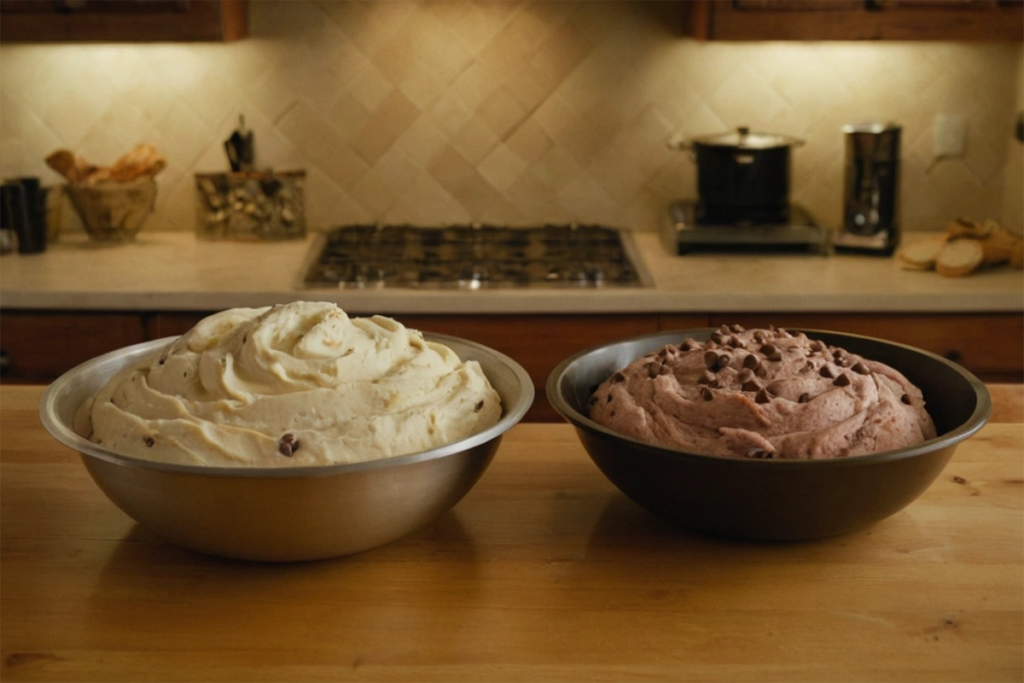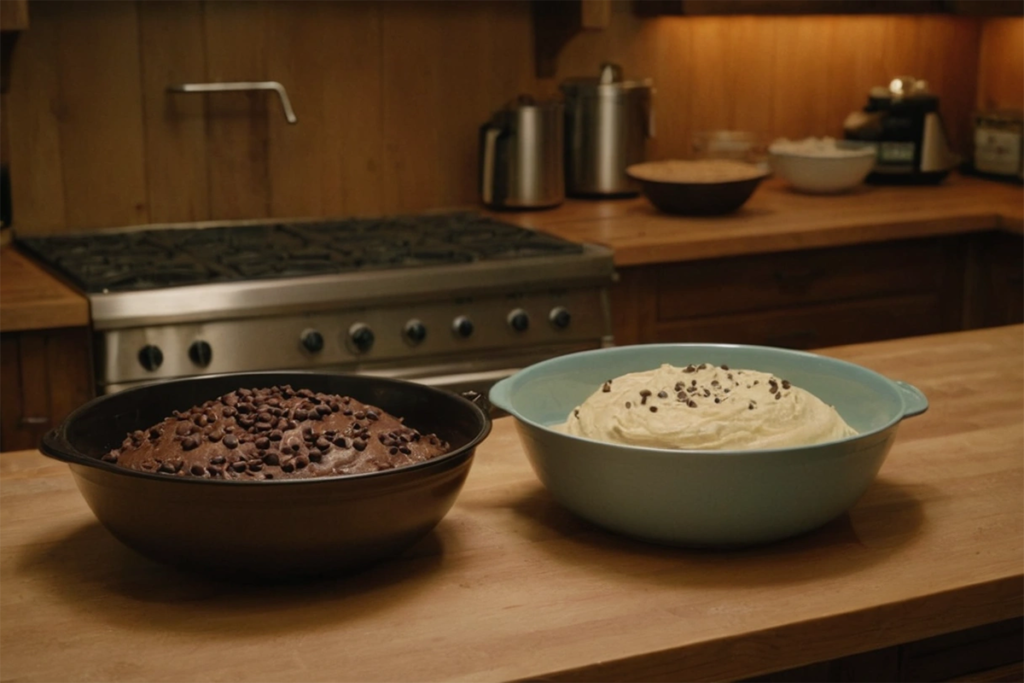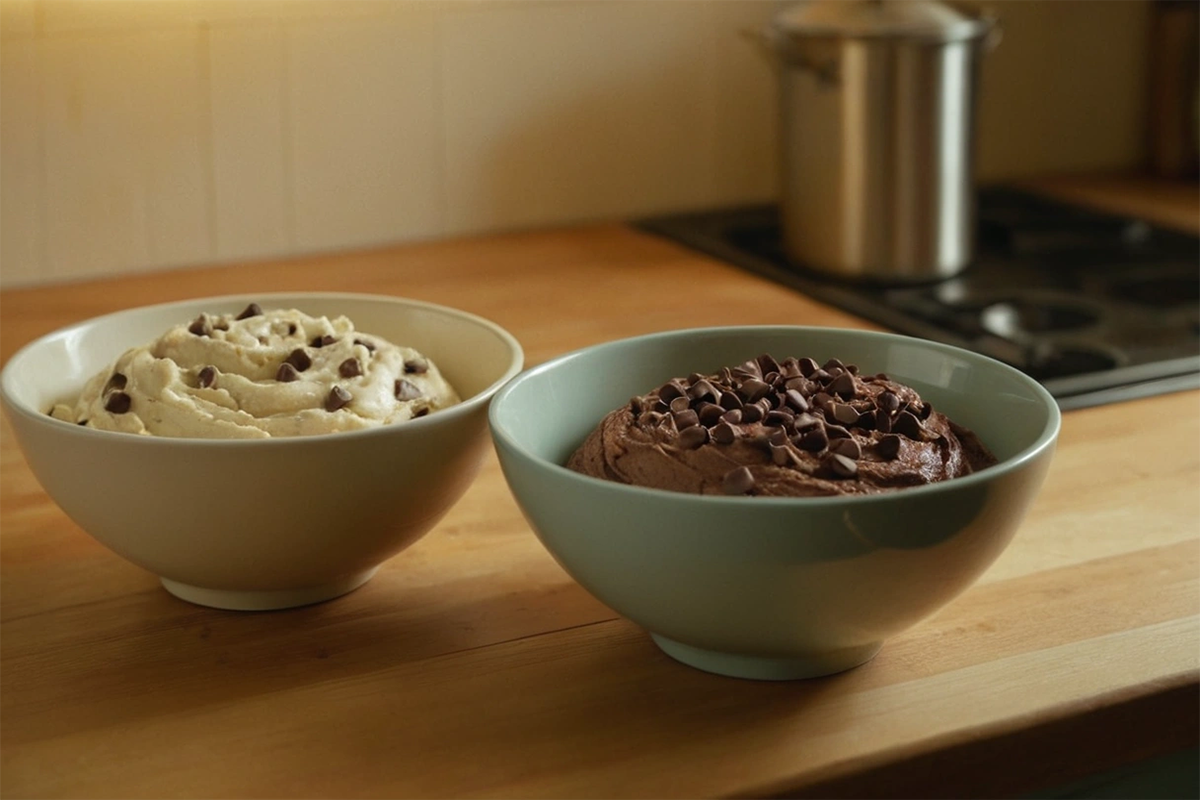Difference between cookie and cake batter is a fundamental concept every baker should understand. When it comes to baking, understanding the difference between cookie batter and cake batter is essential. While cookies and cakes share similar ingredients, how you prepare, mix, and bake them creates entirely different results. Whether you’re looking to whip up a batch of chewy cookies or bake a light, fluffy cake, knowing how each type of batter works will ensure that your baked goods turn out perfectly every time.
This article will explore the key differences between cookie batter and cake batter, focusing on ingredients, mixing techniques, and texture. For those looking to elevate their dessert game, check out our recipe for Strawberry Crunch Cheesecake, which highlights a perfect example of texture contrasts. By the end, you’ll have a solid understanding of what sets these two types of batter apart and how you can use this knowledge to improve your baking skills, similar to mastering the art of making Lemon Cake Mix Cookies.
Table of Contents
Basic Ingredients and Their Functions
Cookie batter and cake batter share some of the same core components, but their proportions and uses differ significantly, affecting the final texture, flavor, and appearance.
1. Key Ingredients in Cookie Batter
Cookies rely on a different balance of ingredients compared to cakes, with a focus on structure and chewiness.
- Flour: In cookie recipes, the flour content is higher than in cakes. This creates a denser, more structured dough, giving cookies their familiar firmness.
- Fat (Butter or Oil): The fat in cookies, often butter or oil, plays a significant role in texture. Creaming butter and sugar together creates air pockets that help cookies become light and chewy. If melted butter is used, it results in denser, chewier cookies.
- Sugar: Cookies tend to have more sugar than cakes, which not only sweetens the dough but also aids in creating that crispy, caramelized edge. The type of sugar used also matters; for example, granulated sugar creates a crunchier texture, while brown sugar adds moisture and chewiness.
- Eggs: In cookies, eggs are generally used in smaller quantities compared to cakes. Eggs help bind the dough together, but too many will make cookies more cake-like.
- Leaveners (Baking Soda/Baking Powder): Baking soda is often used in cookies to help them spread and create a chewy texture. The absence of too much leavening means cookies stay denser and more compact.
2. Key Ingredients in Cake Batter
Cake batter, on the other hand, aims for a light, airy, and fluffy texture.
- Flour: Cake recipes use less flour compared to cookies, which contributes to a softer, more tender crumb. Cake flour is also finer than all-purpose flour, leading to a more delicate texture.
- Fat: Just like in cookies, fat is a key ingredient in cake batter. However, in cakes, you usually cream the butter with sugar to incorporate air into the batter, helping to create a lighter structure.
- Sugar: The sugar in cake batter is responsible for sweetness and moisture. It helps create a soft crumb by tenderizing the gluten in the flour, ensuring the cake is light and moist.
- Eggs: Cakes use more eggs than cookies, which help provide structure and volume. You beat the eggs into the batter to incorporate air, which is critical for the cake’s rise during baking.
- Leaveners (Baking Powder): Unlike cookies, cakes rely more heavily on leaveners like baking powder to create a light, airy texture. The bubbles formed during the chemical reaction between baking powder and moisture help the cake rise.
The balance of these ingredients is crucial in determining whether you’re making a dense cookie or a fluffy cake. You can read more about ingredient functions in baking in this detailed guide to ingredient functions in baking.

The Role of Mixing Methods
How you mix the ingredients for cookie batter and cake batter is just as important as the ingredients themselves. The techniques used can greatly affect the texture and final outcome.
1. Mixing Cookie Batter
In cookie batter, the process often begins with creaming the butter and sugar together. This step creates air pockets in the dough, helping cookies achieve a soft and chewy texture. However, once the flour is added, it’s important not to overmix. Overmixing can develop the gluten in the flour too much, resulting in tough, dense cookies.
- Creaming Butter and Sugar: The creaming method is used to blend butter and sugar until light and fluffy, which creates the right texture for cookies.
- Minimal Mixing After Flour: Once flour is added, the goal is to mix just until combined. Overmixing the dough can lead to tough cookies.
2. Mixing Cake Batter
You usually mix cake batter more vigorously than cookie dough. You cream the fat (butter or oil) with sugar to incorporate as much air as possible. This step is crucial for creating a light, airy cake. You then add the eggs one at a time, and finally, gently fold in the dry ingredients (flour, leaveners) to avoid deflating the batter.
- Beating for Lightness: The key to a fluffy cake is beating the butter and sugar together until the mixture is pale and fluffy, which creates a stable air structure.
- Careful Folding: Once the eggs and flour are added, the batter should be mixed gently to maintain the air bubbles.
For more insights on proper mixing techniques, see this helpful guide on mixing methods for baking.
The Texture Differences Between Cookie and Cake
One of the most noticeable differences between cookie batter and cake batter is the texture of the final product. Cookies have dense, chewy, or crispy textures, while cakes are valued for their light, fluffy, and moist crumb.
1. Cookie Texture
Cookies are dense, and combining the ingredients in specific ways helps them maintain a chewy or crunchy texture depending on the recipe.
- Chewy vs. Crispy: Cookies can be chewy or crispy depending on factors like sugar content and baking time. Chewier cookies typically contain more moisture, while crispy cookies contain less moisture and bake longer at higher temperatures.
- Firmness: Cookies have a firm texture due to the higher ratio of flour to liquid, which makes the dough dense.
2. Cake Texture
Cakes, on the other hand, are meant to be light and fluffy. The high ratio of liquid ingredients and the inclusion of beaten eggs help create this airy structure.
- Light and Fluffy: Cakes are known for their soft, airy texture, achieved by using more liquid and leaveners to help the batter rise.
- Moisture: Eggs, milk, and butter all contribute to a moist cake that retains its softness even after baking.
Baking Times and Temperatures
The differences between cookie batter and cake batter are also evident in how you bake them. Cookies bake at higher temperatures for shorter periods, while cakes bake at lower temperatures for longer periods to ensure even rising and cooking.
1. Cookies
Cookies bake quickly at high temperatures. The high heat helps the cookies set on the outside while keeping the inside soft or chewy.
- High Heat, Short Time: Most cookies are baked at around 350°F to 375°F for 8 to 12 minutes. The goal is to allow the cookies to spread and set quickly.
2. Cakes
Cakes require a more gentle baking process. The batter is thinner, so it needs more time to cook through without burning.
- Lower Heat, Longer Time: Cakes are typically baked at around 325°F to 350°F for 25 to 35 minutes, depending on the size and type of cake. This allows the cake to rise evenly and cook all the way through without becoming too dry on the outside.
Understanding the correct baking times and temperatures is key to achieving the perfect texture in both cookies and cakes.

Variations and Adaptations
Both cookie and cake batters offer opportunities for creativity. Whether you want to create a chewier cookie or a more decadent cake, there are many ways to adapt each type of batter.
1. Common Variations in Cookie Batter
You can easily adapt cookies to suit different tastes by adding ingredients like chocolate chips, nuts, or dried fruits. You can also change the texture by altering the type of sugar or fat used.
- Chocolate Chip Cookies: Adding chocolate chips or chunks gives the dough a rich, gooey texture.
- Nutty Additions: Adding walnuts, pecans, or almonds adds crunch and flavor to cookie dough.
2. Common Variations in Cake Batter
You can flavor cake batter in many ways by adding zests, extracts, or fillings like fruit preserves or ganache.
- Lemon Zest Cake: Adding lemon zest or extract gives the cake a bright, citrus flavor.
- Fruit Filling: Adding a layer of fruit preserves or fresh fruit between cake layers adds moisture and flavor.
3. Crossovers: Cake-Like Cookies and Cookie-Like Cakes
Some baked goods blur the line between cookies and cakes. For example, cake-like cookies have a softer, puffier texture, while dense, cookie-like cakes may have a firmer structure.
- Cake-Like Cookies: These are often puffier, softer, and have a more airy texture, such as whoopie pies or soft sugar cookies.
- Cookie-Like Cakes: Some cakes, like brownies or blondies, have a denser, cookie-like texture with a moist crumb.
FAQs About Cookie and Cake Batter
1. Why is my cookie batter more liquid than usual?
If your cookie batter is more liquid than usual, you may have added too many wet ingredients or used melted butter instead of softened butter. For cookies, the batter should be thick and hold its shape.
2. Can I use cake batter to make cookies?
Technically, you can make cookies from cake batter by adjusting the flour and fat content, but they will have a cake-like texture rather than the dense, chewy texture of typical cookies.
3. Why are cookies crispier than cakes?
Cookies are crispier because they contain less liquid and more fat than cakes, which makes them denser and allows them to dry out during baking.
4. What happens if I overmix cookie or cake batter?
Overmixing either batter can result in tough, dense cookies or cakes because it develops the gluten in the flour, which makes the final product chewy and less tender.
Conclusion
In summary, the primary differences between cookie batter and cake batter come down to the ingredients, mixing methods, and baking techniques used. Cookies are dense, chewy, or crispy due to their higher fat and lower liquid content, while cakes are light, fluffy, and moist thanks to more liquid and leavening agents.
Understanding these differences allows you to confidently tackle any baking project, whether you’re aiming for the perfect chocolate chip cookie or a fluffy vanilla cake. By mastering the balance of ingredients and techniques, you’ll be able to create delicious baked goods tailored to your taste every time. For more detailed insight into the differences between these baked goods, you can explore this Wikipedia article on cakes.

